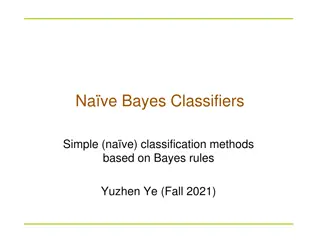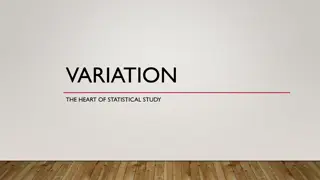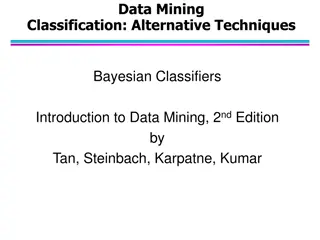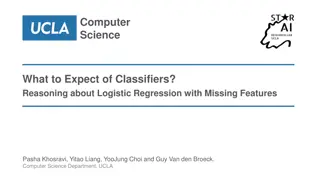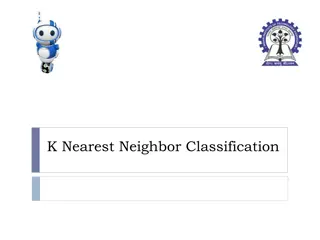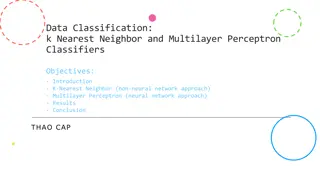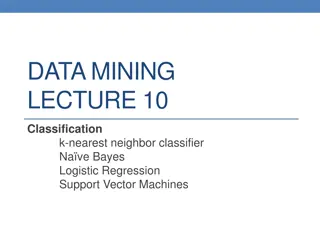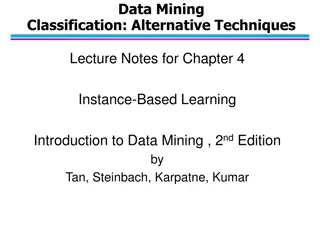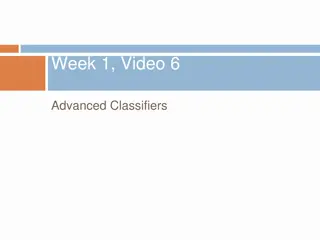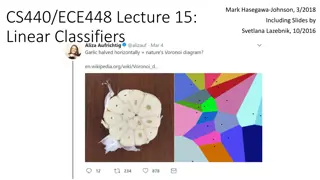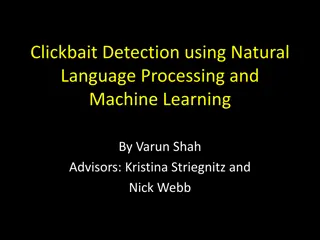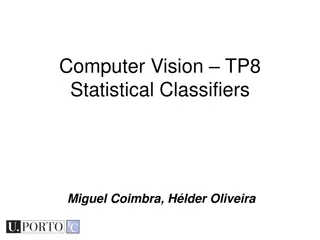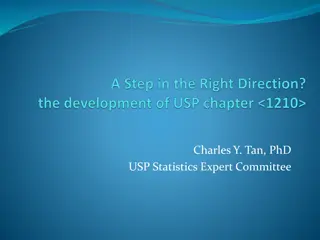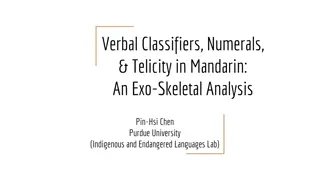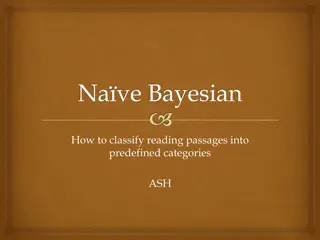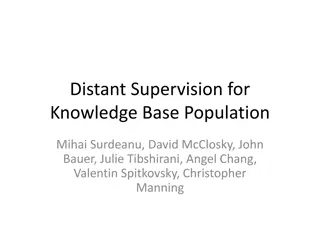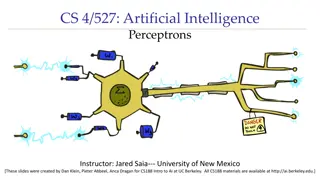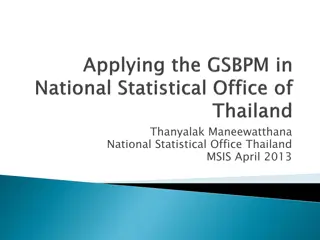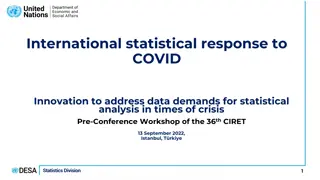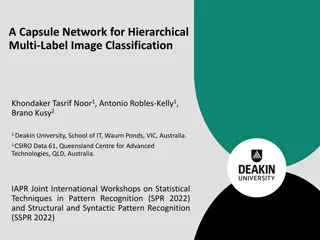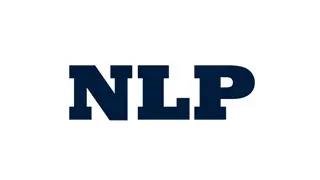Naive Bayes Classifiers and Bayes Theorem
Naive Bayes classifiers, based on Bayes' rules, are simple classification methods that make the naive assumption of attribute independence. Despite this assumption, Bayesian methods can still be effective. Bayes theorem is utilized for classification by combining prior knowledge with observed data,
3 views • 16 slides
Variation in Statistical Studies
Variability is key in statistical studies, shaping the essence of statistical analysis. Students often struggle to grasp the concept of variability, despite being taught statistical methods. The term "variation" takes on different meanings in various statistical contexts, presenting challenges in co
12 views • 54 slides
Introduction to Bayesian Classifiers in Data Mining
Bayesian classifiers are a key technique in data mining for solving classification problems using probabilistic frameworks. This involves understanding conditional probability, Bayes' theorem, and applying these concepts to make predictions based on given data. The process involves estimating poster
3 views • 20 slides
What to Expect of Classifiers: Reasoning about Logistic Regression with Missing Features
This research discusses common approaches in dealing with missing features in classifiers like logistic regression. It compares generative and discriminative models, exploring the idea of training separate models for feature distribution and classification. Expected Prediction is proposed as a princ
8 views • 19 slides
Nearest Neighbor Classifiers in Machine Learning
Nearest Neighbor Classifiers are a fundamental concept in machine learning, including k-Nearest Neighbor (k-NN) Classification. This method involves assigning a test sample the majority category label of its k nearest training samples. The rule is to find the k-nearest neighbors of a record based on
1 views • 32 slides
IBM SPSS for Statistical Analysis
IBM SPSS, formerly known as Statistical Package for the Social Sciences, is a powerful software package for statistical analysis used by researchers across various industries. Developed in the late 1960s, SPSS offers features for data management, statistical analysis, and data documentation. It simp
12 views • 13 slides
Data Classification: K-Nearest Neighbor and Multilayer Perceptron Classifiers
This study explores the use of K-Nearest Neighbor (KNN) and Multilayer Perceptron (MLP) classifiers for data classification. The KNN algorithm estimates data point membership based on nearest neighbors, while MLP is a feedforward neural network with hidden layers. Parameter tuning and results analys
0 views • 9 slides
Nearest Neighbor Classification in Data Mining
Classification methods in data mining, like k-nearest neighbor, Naive Bayes, Logistic Regression, and Support Vector Machines, rely on analyzing stored cases to predict the class label of unseen instances. Nearest Neighbor Classifiers use the concept of proximity to categorize data points, making de
1 views • 58 slides
Introduction to Instance-Based Learning in Data Mining
Instance-Based Learning, as discussed in the lecture notes, focuses on classifiers like Rote-learner and Nearest Neighbor. These classifiers rely on memorizing training data and determining classification based on similarity to known examples. Nearest Neighbor classifiers use the concept of k-neares
2 views • 13 slides
Advanced Classifiers and Neural Networks
This content explores the concept of advanced classifiers like Neural Networks which compose complex relationships through combining perceptrons. It delves into the workings of the classic perceptron and how modern neural networks use more complex decision functions. The visuals provided offer a cle
6 views • 26 slides
Enhancing Statistical Capacities of OIC Member Countries to Achieve SDGs: The Role of SESRIC
This presentation discusses the importance of enhancing statistical capacities in OIC member countries to achieve Sustainable Development Goals (SDGs), with a focus on the role of SESRIC. It covers the evolution of statistical definitions, the use of Statistical Capacity Index (SCI) for analysis, an
15 views • 17 slides
Linear Classifiers and Naive Bayes Models in Text Classification
This informative content covers the concepts of linear classifiers and Naive Bayes models in text classification. It discusses obtaining parameter values, indexing in Bag-of-Words, different algorithms, feature representations, and parameter learning methods in detail.
5 views • 38 slides
Classifiers in Data Analysis
In data analysis, classifiers play a crucial role in predicting categorical outcomes based on various features within the data. Through models and algorithms, classifiers can be used to make predictions about the future or infer present situations. Various classification methods and techniques are e
3 views • 50 slides
Clickbait Detection: Using NLP and Machine Learning for Identifying Deceptive Content
Explore the realm of clickbait through a detailed investigation into identifying and combating misleading content online. With initiatives like the Clickbait Challenge and innovative feature analysis, researchers aim to enhance algorithms and classifiers for accurate detection. Preliminary results s
3 views • 16 slides
Statistical Classifiers in Computer Vision
Exploring statistical classifiers such as Support Vector Machines and Neural Networks in the context of computer vision. Topics covered include decision-making using statistics, feature naming conventions, classifier types, distance measures, and more.
1 views • 39 slides
Statistical Tools for Method Validation in USP General Chapter 1210
In the USP General Chapter 1210, Statistical Tools for Method Validation are outlined, serving as a companion to the validation of Compendial Procedures. The chapter covers important topics like Accuracy, Precision, Linearity, LOD, LOQ, and range. It emphasizes statistical tools such as TOST, statis
1 views • 22 slides
Statistical Classifiers in Computer Vision
This content delves into the utilization of statistical classifiers within computer vision, particularly focusing on their application and significance in the field. The exploration spans various methodologies and techniques employed to enhance the efficiency and accuracy of classifiers when analyzi
2 views • 34 slides
Probabilistic Classifiers in Computer Vision and Image Processing
In this lecture, we delve into probabilistic classifiers like the Naïve Bayes classifier and Logistic regression in the realm of Computer Vision and Image Processing. Explore topics such as representing joint distributions, independent random variables, conditional independence, and Bayesian Networ
9 views • 24 slides
Verbal Classifiers & Telicity in Mandarin: An Exo-Skeletal Analysis
Mandarin, Verbal classifiers, Telicity, Exo-Skeletal
1 views • 23 slides
Classifying Reading Passages into Categories with Naive Bayesian
Text classification involves assigning reading passages to predefined categories for purposes like spam detection, authorship identification, and sentiment analysis. This process includes document pre-processing, feature indexing, applying classification algorithms, and performance measurement. Pre-
4 views • 35 slides
Distant Supervision for Knowledge Base Population: Training and Challenges
Distant supervision is utilized for knowledge base population, with a focus on slot filling tasks and generating training data automatically from Wikipedia infoboxes. The approach involves mapping infobox fields to slots, finding relevant sentences using information retrieval, and training multiclas
2 views • 5 slides
Artificial Intelligence Perceptrons: Linear Classifiers and Geometric Explanation
In these slides, explore the concept of artificial intelligence perceptrons including linear classifiers, feature vectors, and geometric explanations. Learn about weight updates and the learning process of binary perceptrons. Understand how weights are adjusted based on training instances and delve
3 views • 24 slides
Statistical Business Processes and Models at NSO Thailand
The National Statistical Office of Thailand has been developing various statistical business processes and models, including the Generic Statistical Business Process Model and Draft Good Statistical Practice Guidelines. The agency is striving to align its operations with international standards like
8 views • 11 slides
From Linear Classifiers to Neural Networks - A Comprehensive Overview
This content delves into the transition from linear classifiers to neural networks, covering topics such as discriminant functions, cost functions, loss functions, and the structure of linear classifiers. Explore the representation power of sigmoidal neural networks and the challenges posed by non-d
2 views • 33 slides
Statistical Response to COVID-19 Innovation Addressing Data Demands
International statistical response to COVID-19 focused on addressing data demands for statistical analysis during times of crisis. The Global COVID-19 survey of NSOs highlighted the challenges and thematic areas covered. Decision 52/102 by the Statistical Commission emphasized the importance of moni
4 views • 19 slides
Ensemble Methods in Machine Learning
Ensemble methods in machine learning involve combining multiple classifiers to improve accuracy and diversity. By leveraging statistical, computational, and representational reasons, ensemble methods can effectively address the limitations of individual classifiers. Bayesian Voting is one such metho
9 views • 20 slides
Classification Techniques and Decision Boundaries
Classification techniques such as Nearest Neighbor Classifiers, Support Vector Machines, and Ensemble Methods play a crucial role in learning good decision boundaries to separate different classes in a dataset. Instance-based classifiers utilize stored cases for predicting class labels of unseen cas
0 views • 26 slides
Capsule Network for Multi-Label Image Classification Study
Explore a Capsule Network for Hierarchical Multi-Label Image Classification through a detailed analysis of classification approaches, hierarchical structure, and CapsNet models. This study delves into Class Taxonomy, Hierarchical Classifiers, CNN-Based Classifiers, and Capsule Networks' innovative f
1 views • 19 slides
Statistical Classifiers in Computer Vision Explained
Statistical classifiers play a crucial role in Computer Vision, enabling decision-making through statistical analysis and pattern recognition. This collection delves into various aspects of statistical classifiers, including support vector machines, neural networks, feature extraction, distance meas
0 views • 39 slides
Bayes Classifiers Exercises and Solutions
Dive into Bayes Classifiers through a series of exercises covering Bayes Theorem and its practical applications in various scenarios like population demographics, production defects in machines, and email classification. This comprehensive guide provides detailed explanations and solutions to help e
2 views • 17 slides
Linear Classifiers in Computer Vision & Deep Learning
Explore the intricacies of linear classifiers in the realm of computer vision and deep learning, including disadvantages of k-NN, parameterized score functions, bias tricks, image data preprocessing, and more. Learn how linear classifiers map raw data to class scores and interpret results effectivel
0 views • 23 slides
Mandarin Verbal Classifiers, Numerals, and Telicity
Explore the relationship between verbal classifiers, numerals, and telicity in Mandarin, along with formal representations and the Exo-Skeletal Model. Understand telicity's origins, the functions of verbal classifiers, and how they contribute to telic interpretations. Dive into empirical evidence an
0 views • 23 slides
Bayesian Classifiers in Data Mining
Learn about Bayesian Classifiers and their application in data mining, including Nave Bayes Classifier, Bayes Theorem examples, and using Bayes Theorem for classification. Understand how to estimate probabilities and compute posterior probabilities for classification problems.
0 views • 16 slides
Introduction to NLP Generative vs Discriminative Models
Explore the differences between Generative and Discriminative Models in Natural Language Processing (NLP). Learn about the assumptions of Discriminative Classifiers, the effectiveness of Discriminative vs Generative Classifiers, and dive into the Naïve Bayes Generative Classifier. Understand concep
1 views • 23 slides
Introduction to Bayesian Classifiers in Data Mining
Explore the use of Bayesian classifiers in data mining for classification tasks. Learn about the probabilistic framework, Bayes' theorem, and how to estimate posterior probabilities for predicting class labels based on given attributes. Utilize examples and techniques to understand and apply Bayesia
3 views • 26 slides
Statistical Ensemble in Statistical Physics
This chapter explains the fundamental concept of statistical ensemble in statistical physics, emphasizing the analysis of an ensemble of identical macroscopic systems to understand macroscopic values. It explores the construction of representing statistical ensembles based on macrostates defined by
0 views • 31 slides
Efficient Sketching of Linear Classifiers over Data Streams
Explore the WM-Sketch methodology for training linear classifiers over data streams with limited memory while maintaining accuracy and adaptability to evolving patterns.
4 views • 18 slides
Discriminative Classifiers and Maximum A Posteriori in Machine Learning
Explore discriminative classifiers like Logistic Regression and SVMs, and delve into Maximum A Posteriori estimation for Bayesian inference. Learn about the different classification strategies, linear algebra concepts, feature space representation, and the dot product in machine learning.
1 views • 43 slides
Noisy Iris Recognition: A Comparison of Classifiers and Feature Extractors
A study on noisy iris recognition comparing various classifiers and feature extractors. The research delves into biometrics, uniqueness factor, verification, classification, Gabor filters, AdaBoost, ROC analysis, methodology, results, and references. The study involves 480 pairs of inter-class and i
4 views • 9 slides
Fitting a Model to Data: Linear Classifiers and Discriminant Functions
Explore the concepts of fitting a model to data using linear classifiers like linear regression and logistic regression, and linear discriminant functions. Learn about simplifying assumptions for classification, agenda topics such as tree induction vs. logistic regression, and the instance-space vie
2 views • 30 slides
